The Sandy Bridge Pentium Review: G850, G840, G620 & G620T Tested
by Anand Lal Shimpi on August 23, 2011 12:11 AM ESTThe Test
As always we're only presenting a subset of our entire CPU test suite here. For all of the numbers as well as other comparison options check out Bench.
| CPU: |
AMD A8-3850, AMD A6-3650, AMD Athlon II X4 635, AMD Athlon II X3 455, AMD Athlon II X2 265 Intel Core i3-2100, Intel Core i3 540, Intel Pentium G850, Intel Pentium G840, Intel Pentium G620, Intel Pentium G620T |
| Motherboard: |
Intel DH67BL (Intel H67) ASRock A75 Extreme6 (AMD A75) |
| Chipset Drivers: |
Intel 9.2.0.1025 AMD Catalyst 8.862 RC1 |
| Hard Disk: | Intel X25-M (80GB), Corsair P256 SSD (256GB) |
| Memory: | G.Skill DDR3-1866 2 x 4GB |
| Video Drivers: |
AMD Catalyst 8.862 RC1 Intel 2372 |
| Desktop Resolution: | 1920 x 1200 |
| OS: | Windows 7 x64 |
Adobe Photoshop CS4 Performance
To measure performance under Photoshop CS4 we turn to the Retouch Artists’ Speed Test. The test does basic photo editing; there are a couple of color space conversions, many layer creations, color curve adjustment, image and canvas size adjustment, unsharp mask, and finally a gaussian blur performed on the entire image.
The whole process is timed and thanks to the use of Intel's X25-M SSD as our test bed hard drive, performance is far more predictable than back when we used to test on mechanical disks.
Time is reported in seconds and the lower numbers mean better performance. The test is multithreaded and can hit all four cores in a quad-core machine.
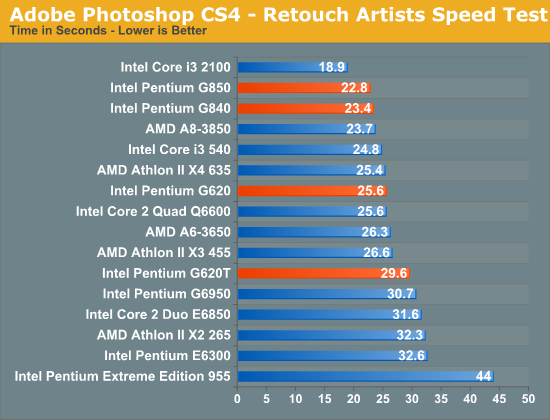
The Pentium G620 does a lot better than its Athlon II X2 counterpart, there's no contest here. The race is a lot closer between the G840/850 and the Athlon II X3 455, but in the end the Pentiums are faster. Both perform a bit better than the more expensive AMD A8-3850.
x264 HD Video Encoding Performance
Graysky's x264 HD test uses the publicly available x264 encoder to transcode a 4Mbps 720p MPEG-2 source. The focus here is on quality rather than speed, thus the benchmark uses a 2-pass encode and reports the average frame rate in each pass.
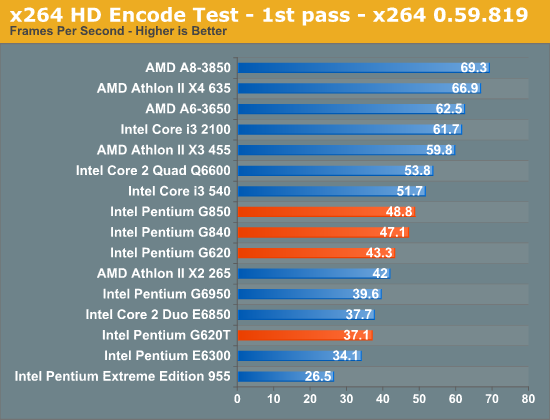
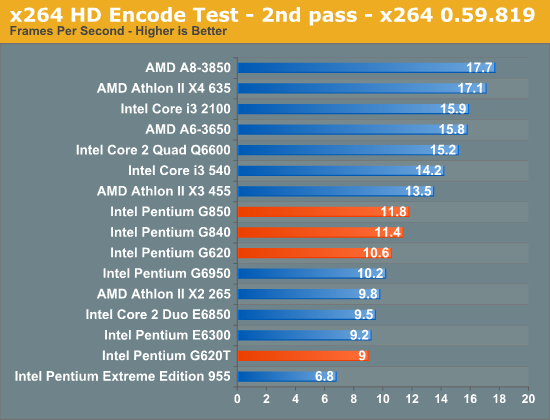
Once again the G620 is faster than the Athlon II X2 265 despite the latter's clock speed advantage. The G840 and G850 are faster than the 620 but not fast enough to overcome the extra core advantage of the X3 455. If you're spending $80 on a CPU for video encoding go for the Athlon II X3 455.
3dsmax 9 - SPECapc 3dsmax CPU Rendering Test
Today's desktop processors are more than fast enough to do professional level 3D rendering at home. To look at performance under 3dsmax we ran the SPECapc 3dsmax 8 benchmark (only the CPU rendering tests) under 3dsmax 9 SP1. The results reported are the rendering composite scores:
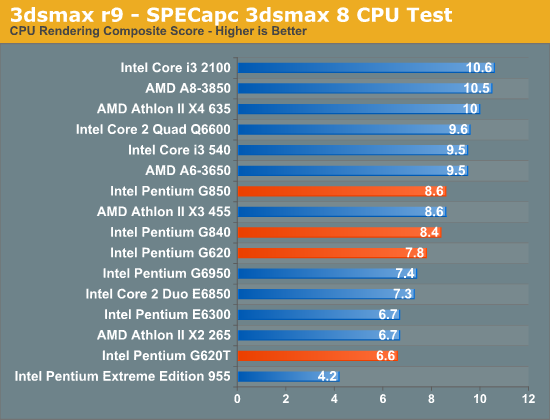
Not all heavily threaded tasks are going to favor more cores. In this case the IPC advantages of Sandy Bridge give the G850 equal performance to the X3 455.
Cinebench R10
Created by the Cinema 4D folks we have Cinebench, a popular 3D rendering benchmark that gives us both single and multi-threaded 3D rendering results.
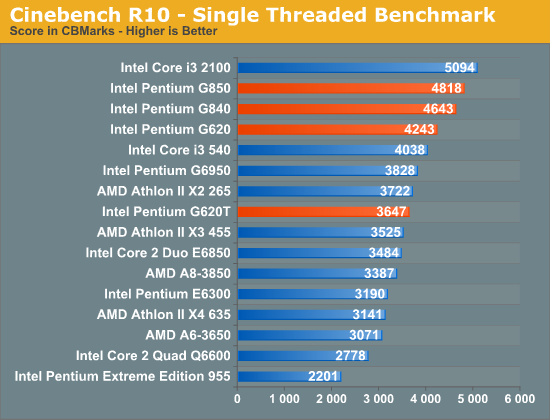
Single threaded performance is going to be a big advantage of the SNB Pentiums. Even the G620 is a good 14% faster than AMD's Athlon II X2 265 and the rest scale up with clock speed. What this translates to is great general use performance as well as solid performance in those apps that are still bound by the performance of a single thread.
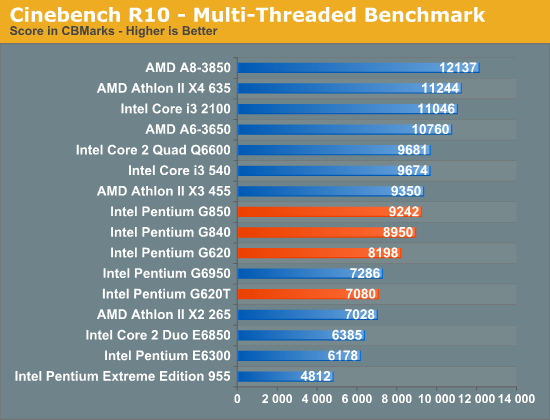
Multithreaded apps however start to benefit from more cores. In this case the Athlon II X3 455 isn't much faster than a G850 and only 4.5% faster than a G840, despite its core count advantage.
PAR2 Multithreaded Archive Recovery Performance
Par2 is an application used for reconstructing downloaded archives. It can generate parity data from a given archive and later use it to recover the archive
Chuchusoft took the source code of par2cmdline 0.4 and parallelized it using Intel’s Threading Building Blocks 2.1. The result is a version of par2cmdline that can spawn multiple threads to repair par2 archives. For this test we took a 708MB archive, corrupted nearly 60MB of it, and used the multithreaded par2cmdline to recover it. The scores reported are the repair and recover time in seconds.
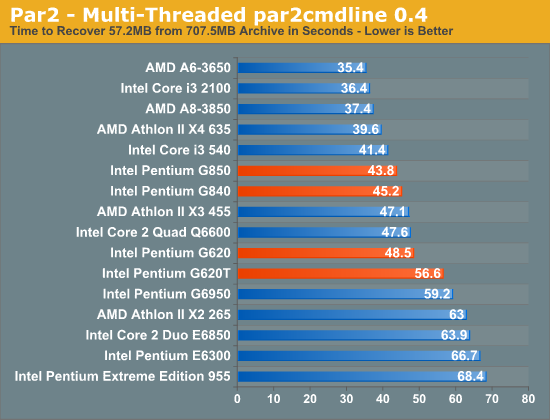
Our Par2 extraction test is another multithreaded scenario where two Sandy Bridge cores manage to slightly outperform three Athlon II cores. Whereas before it was a pretty simple "more cores, better multithreaded performance" argument, the SNB Pentiums do complicate things a bit.
WinRAR - Archive Creation
Our WinRAR test simply takes 300MB of files and compresses them into a single RAR archive using the application's default settings. We're not doing anything exotic here, just looking at the impact of CPU performance on creating an archive:
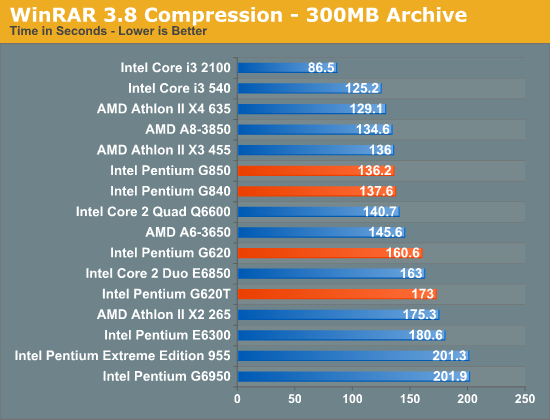
Once again we've got a multithreaded test with a murky outcome. The G850 is hot on the heels of the Athlon II X3 455, as is the G840.
Gaming Performance
Our first set of gaming performance results come using a discrete GPU. In the case of the Crysis Warhead results it's a GeForce GTX 280, while everything else uses a Radeon HD 5870. Across the board the Pentium manages to do better than its Athlon II competitors, of course with a discrete GPU that's not unexpected. Next we'll see how these stack up with processor graphics.
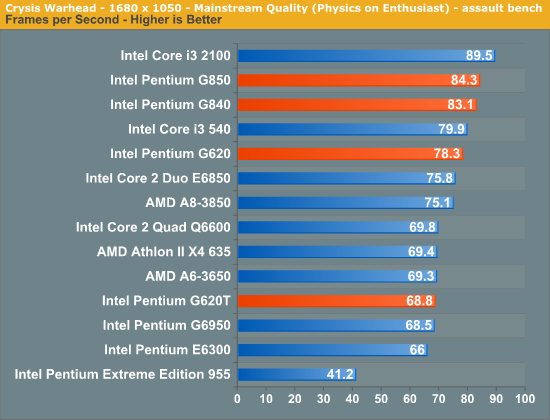
Dragon Age Origins is another very well received game. The 3rd person RPG gives our CPUs a different sort of workload to enjoy:
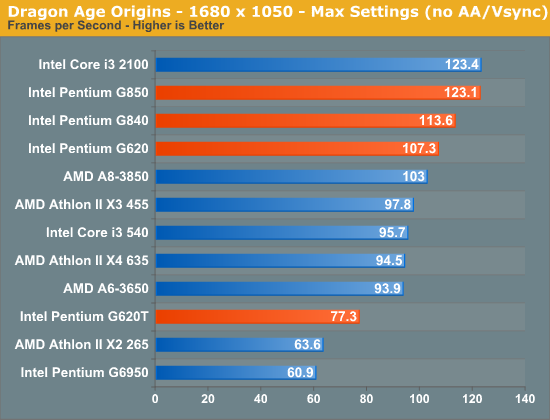
World of Warcraft needs no introduction. An absurd number of people play it, so we're here to benchmark it. Our test favors repeatability over real world frame rates, so our results here will be higher than in the real world with lots of server load. But what our results will tell you is what the best CPU is to get for playing WoW:
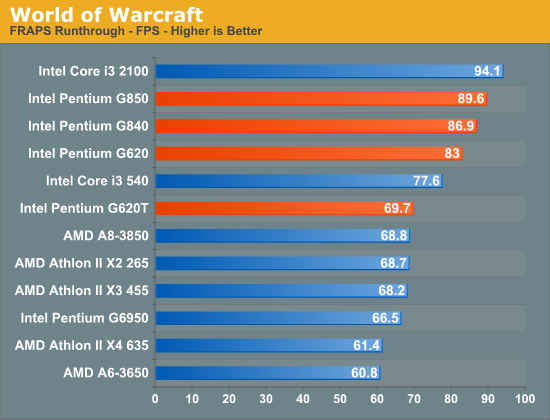
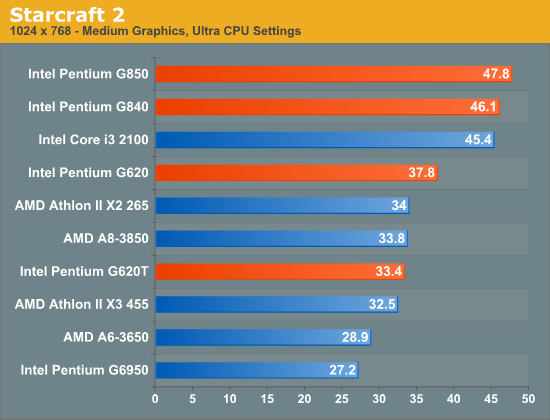
Power Consumption
The new Pentiums draw very little power, not only compared to their AMD counterparts but also the rest of the Sandy Bridge lineup.Without Hyper Threading, overall execution resource utilization is lower and thus power consumption is lower. It doesn't look like any of these chips come close to hitting their max TDPs as the Pentium G620T only draws 4W less than the G620 despite being rated with a 30W lower TDP.
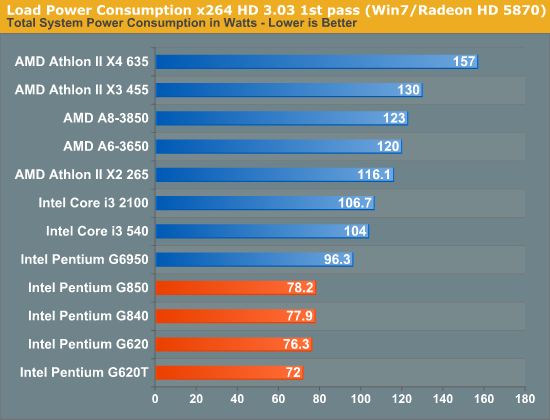










110 Comments
View All Comments
yankeeDDL - Monday, September 5, 2011 - link
Averik, positive exchange of opinion and ideas is always nice, I think :)I wrote another comment a few pages down about comparing power consumption.
It is very difficult to compare power consumption based on the data above, however, a "quick and dirty" comparison can be done using the data from the graphs of the H264 decoding and the power under load.
You can see that the G620 uses 55% of the power of the X3, but the X3 takes 60% of the time to do the compression.
What this means is that under load, the G620 consumes less, but the X3 goes back idle much faster than the G620. Of course, this is one specific scenario: in general, it's clear that the G620 is more efficient, but also slower.
Considering the type of applications you indicate, I think the amount of time when the system will be at max power will be extremely low, compared to the idle time.
Unfortunately Anand did not compare the idle power consumption between these CPUs.
This page compares system level power consumption of both the X3 and the G620 (http://www.xbitlabs.com/articles/cpu/display/penti... and shows again the X3 on top. In the comment you see that with other MoBos the G620 idle power can be shaver a little and be made, at best, the same.
So I stand by my position: the G620 offers no advantage over the Athlon X3, and this includes power consumption considerations (at system level, which is what matters). Considering the price difference and the 3rd core, I would not consider the low-end sandy bridge for my budget PCs.
CeriseCogburn - Thursday, January 3, 2013 - link
Exactly, and that newer platform has a gigantic upgrade path years from now while the amd system has jack nothing.When the company wants to throw the systems away, all the employees will want one because they can drop a 2500K in it for the $50 it will cost then, and have a freaking screamer of system again. Or one of the new IB's.
The amd boards won't make it in tact to the trash bin. No one will want them.
TypeS - Thursday, August 25, 2011 - link
Brand recognition, plain and simple. That is why Intel releases these chips and why they will sell. Agree with the ways Intel has grown in the last 2 decades, they have the market leader spot and will use it. Intel was the company that created the x86 design and AMD would be nothing today without it's tech and government forcing cross-licensing agreements down Intel's throat.Remember the percentage of us that actually read these reviews, go to these websites and know that actual statistics of all the various PC components is pretty small compared to the size of the consumer market. People usually walk into a Best Buy (or other big box store) and see two things to base their decisions on, brand and price.
You see the same with cars. People buy the ridiculously overpriced german, italian and bristish "luxury" cars when the same quality can be found in premium Japanese cars and some luxury American models. It's brand recognition. Who wins in performance charts means little in the end.
CeriseCogburn - Thursday, January 3, 2013 - link
A few year down the line in hoes the IB or 2500K or 2600K and suddenly the piece of crap is a MONSTER.The amd board - stomp it. It loses, screw any upgrade.
Oh look at that... only a freaking fool would buy the amd rig now.
JD_Mortal - Monday, May 6, 2013 - link
Because 90% of computer users only do "basic stuff" with thier computers.Because, AC is more expensive than heat.
Because having 2000 computers that constantly draw 95Watts at idle, and not being used, is more expensive to operate for four years, than 2000 running at 23Watts at idle.
Because "We" (the people buying them, who are the majority of sales), keep asking for it. Thus, fueling the few sales and development of YOUR overpriced and over powered (wattage-power), making them within your actual budget. (Without OUR sales, YOUR chips would still be on 65nm, and cost $1000 per CPU. Oh, you are welcome BTW.)
algida79 - Tuesday, August 23, 2011 - link
Hi Anand. I think that the phrasing under the x264 comparison charts:"Without Quick Sync, the Pentiums have to rely on raw CPU power for video encoding performance."
is a bit misleading. It implies that the presence of QuickSync would benefit the Pentiums' performance in x264 encoding, which is not the case.
Anand Lal Shimpi - Tuesday, August 23, 2011 - link
Very true - fixed :)Take care,
Anand
Arnulf - Tuesday, August 23, 2011 - link
How about that par2 test, is it true that the lower clock A6-3650 is faster at this one than A8-3850 ?ckryan - Tuesday, August 23, 2011 - link
But I don't think the celeron line deserves to continue.These Pentiums aren't unattractive neccessarily. If you think about it, they're faster than a comparable i3-5xx series, have better IGPs and use less power. You can't over clock them, nor can they hyperthread, but they're not useless. The celeron line refresh is a different story -- though I suppose you could say the 1155 celerons are the best ever... not that it's saying much. I have a spare 1155 H67 board laying around that could be inexpensively outfitted with a Pentium for not much cash, but the question remains whether the Athlon II X3 it would replace would be better served by retirement. The answer is probably no -- it's not worth the $78 for a lateral move. If you're building a budget system from scratch you'll probably need to decide whether a super cheap H61 board and a Pentium is a good investment, and I think most people would be better served with an Athlon II system if you can't fit Llano or a H67/z68 i3 setup into your budget. But if you're in the market, a G620/H61/4GB DDR3/Rosewill Case and PSU combo is less than $200 at Newegg. So I'd say buy whatever is on sale. Add $120 for a cheap SSD and DVD burner and you have a system that could do everything but game, or choose to get a entry level GPU like the 6600 series and you could game pretty well for such a modest system.
CeriseCogburn - Monday, June 25, 2012 - link
The problem with your thinking is after some time one can drop a 2500K SB in the dirt cheap pentium board and be miles ahead of any amd setup, which cannot and will not do the same thing.So if you go amd you've screwed yourself forever.